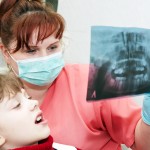
The experience of pain during the injection of local anaesthesia is considered a potential cause of dental fear and anxiety particularly for children. A range of approaches including topical anaesthesia, warming anaesthetics, and the use of buffered anaesthetics, distraction techniques and computerised injection have been suggested. Another approach is the use of counter irritation where vibratory or a pressure stimulus is applied adjacent to the injection site. This has been studied for studied for dental injections with mixed results.
The aim of this review was to evaluate the effect of vibrating devices on paediatric dental injection pain reduction.
Methods
Searches were conducted in the Cochrane, Embase, PubMed and Scopus databases for English language studies evaluating dental injection accompanied by intra- or extra-oral vibration device against injection alone in children under the age of 12 were considered. Two reviewers selected studies, extracted data and assessed risk of bias based on the Cochrane risk of bias approach.
Results
- 6 RCTs (4 split mouth, 2 parallel) involving a total of 373 children were included.
- All the studies were considered to be at high risk of bias as patients and dentists were not blind to the intervention.
- 4 studies used DentalVibe, 2 studies the Buzzy.
- All 6 studies used the Wong–Baker faces pain rating scale, 4 studies also used the Faces, Legs, Arms, Crying, Consolability (FLACC) behaviour pain scale.
- Random effects meta-analysis showed no statistical difference between the DentalVibe and the control for either the FLACC score or Wong-Baker Faces score.
| Mean Difference (95%CI) | |
| FLACC score | 0.057 (-0.279 to 0.392) |
| Wong-Baker Faces score | 0.009 (-0.372 to 0.390) |
Conclusions
The authors concluded: –
……use of DentalVibe for paediatric dental injections was not effective in reducing pain perception although the evaluated studies were limited and of low quality. However, Buzzy device indicated promising results as shown by two studies included in this review. Further high-quality studies are suggested to provide a better insight into the impact of these vibration devices on reducing pain perception in children.
Comments
The authors have searched a good range of databases up to March 2020. However, restricting their inclusion to studies published in English means that some relevant studies may have been excluded. There is a lack of detail in the methodological section and it is unclear was to whether independent and duplicate study selection, data extraction and risk of bias assessment has been undertaken although they do indicate that the methodology was conducted in line with the Preferred Reporting Items for Systematic Reviews and Meta-Analysis (PRISMA statement). Only 6 RCTs were included and because of the nature of the intervention it is difficult to blind either the patients or operator to the intervention, so all the included studies were considered to be at high risk of bias. It is worth noting that all the studies with the exception of one used topical anaesthesia in both the test and control groups.
The findings suggest that there was no benefit from the DentalVibe and while the authors indicate that the Buzzy device may be more promising the available evidence is very limited. Last year (Dental Elf – 2nd Mar 2020) we looked at a Cochrane review looking at a broader range of interventions to improve the acceptance of local anaesthetic in children. Their findings indicated that there was insufficient evidence to draw conclusions and that the methodology of studies in this area needs to be improved in order to benefit children requiring local anaesthesia.
Links
Primary Paper
Faghihian R, Rastghalam N, Amrollahi N, Tarrahi MJ. Effect of vibration devices on pain associated with dental injections in children: A systematic review and meta-analysis. Aust Dent J. 2020 Nov 30. doi: 10.1111/adj.12811. Epub ahead of print. PMID: 33258142.
Other references
Dental Elf – 2nd Mar 2020
Local anaesthetic for dental treatment: interventions to improve acceptance in children
Dental Elf – 6th Dec 2019
